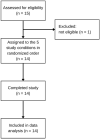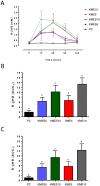Tolerability and Acceptability of an Exogenous Ketone Monoester and Ketone Monoester/Salt Formulation in Humans
- PMID: 38068734
- PMCID: PMC10708260
- DOI: 10.3390/nu15234876
Tolerability and Acceptability of an Exogenous Ketone Monoester and Ketone Monoester/Salt Formulation in Humans
Abstract
Exogenous ketone ester and ketone ester mixed with ketone free acid formulations are rapidly entering the commercial marketspace. Short-term animal and human studies using these products suggest significant potential for primary or secondary prevention of a number of chronic disease conditions. However, a number of questions need to be addressed by the field for optimal use in humans, including variable responses among available exogenous ketones at different dosages; frequency of dosing; and their tolerability, acceptability, and efficacy in long-term clinical trials. The purpose of the current investigation was to examine the tolerability, acceptability, and circulating R-beta-hydroxybutyrate (R-βHB) and glucose responses to a ketone monoester (KME) and ketone monoester/salt (KMES) combination at 5 g and 10 g total R-βHB compared with placebo control (PC). Fourteen healthy young adults (age: 21 ± 2 years, weight: 69.7 ± 14.2 kg, percent fat: 28.1 ± 9.3%) completed each of the five study conditions: placebo control (PC), 5 g KME (KME5), 10 g KME (KME10), 5 g (KMES5), and 10 g KMES (KMES10) in a randomized crossover fashion. Circulating concentrations of R-βHB were measured at baseline (time 0) following an 8-12 h overnight fast and again at 15, 30, 60, and 120 min following drink ingestion. Participants also reported acceptability and tolerability during each condition. Concentrations of R-βHB rose to 2.4 ± 0.1 mM for KME10 after 15 min, whereas KMES10 similarly peaked (2.1 ± 0.1 mM) but at 30 min. KME5 and KMES5 achieved similar peak R-βHB concentrations (1.2 ± 0.7 vs. 1.1 ± 0.5 mM) at 15 min. Circulating R-βHB concentrations were similar to baseline for each condition by 120 min. Negative correlations were observed between R-βHB and glucose at the 30 min time point for each condition except KME10 and PC. Tolerability was similar among KME and KMES, although decreases in appetite were more frequently reported for KMES. Acceptability was slightly higher for KMES due to the more frequently reported aftertaste for KME. The results of this pilot investigation illustrate that the KME and KMES products used increase circulating R-βHB concentrations to a similar extent and time course in a dose-dependent fashion with slight differences in tolerability and acceptability. Future studies are needed to examine variable doses, frequency, and timing of exogenous ketone administration for individuals seeking to consume ketone products for health- or sport performance-related purposes.
Keywords: ketogenic diet; ketones; ketosis; metabolism; obesity.
Conflict of interest statement
The authors declare no conflict of interest. The funders had no role in the design of this study; in the collection, analyses, or interpretation of data; in the writing of the manuscript; or in the decision to publish the results.
Figures






References
-
- Drabińska N., Wiczkowski W., Piskuła M.K. Recent advances in the application of a ketogenic diet for obesity management. Trends Food Sci. Technol. 2021;110:28–38. doi: 10.1016/j.tifs.2021.01.080. - DOI
Publication types
MeSH terms
Substances
Grants and funding
LinkOut - more resources
Full Text Sources

